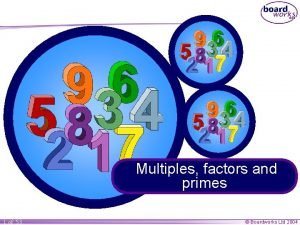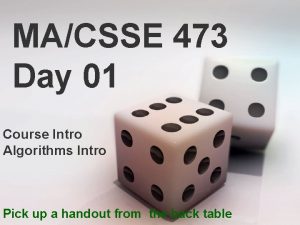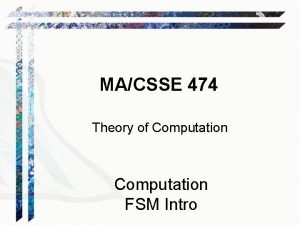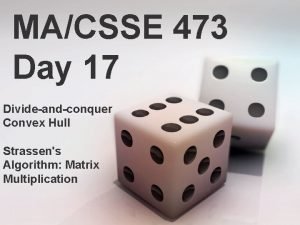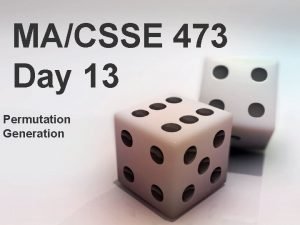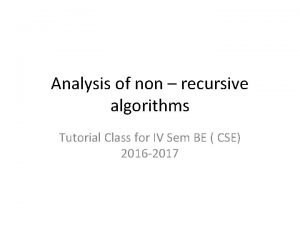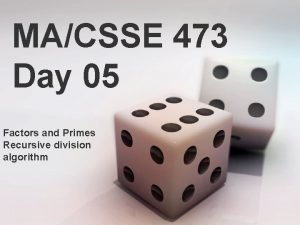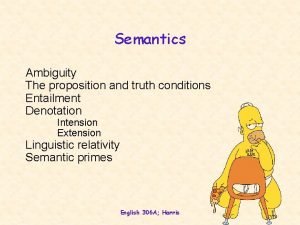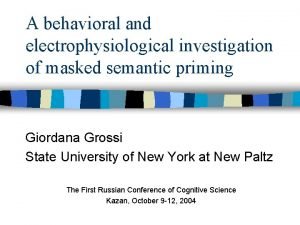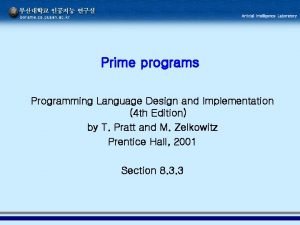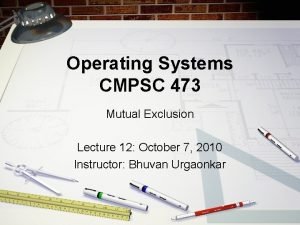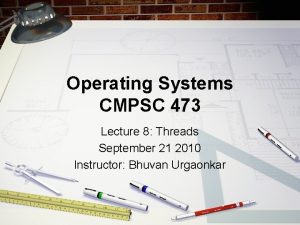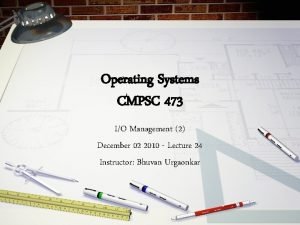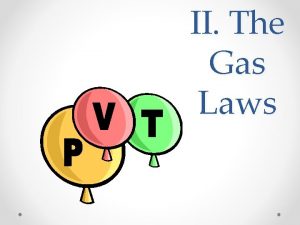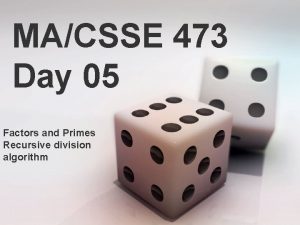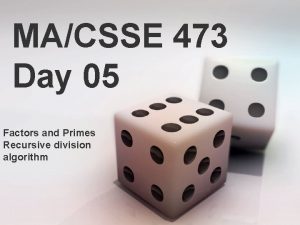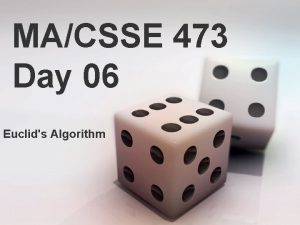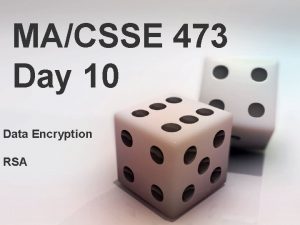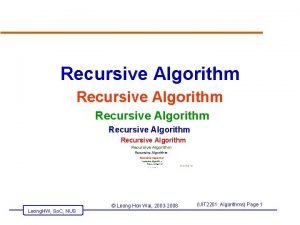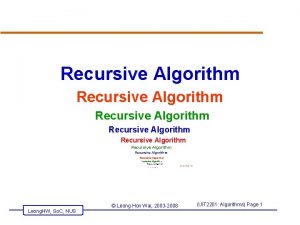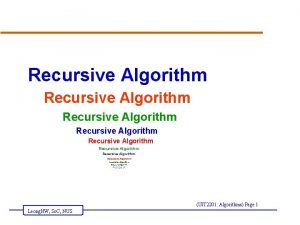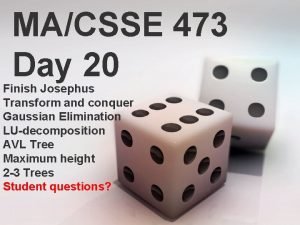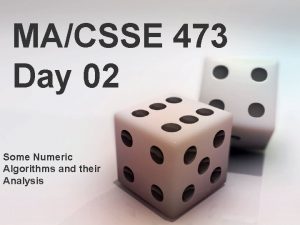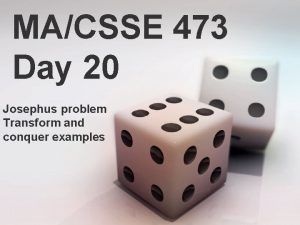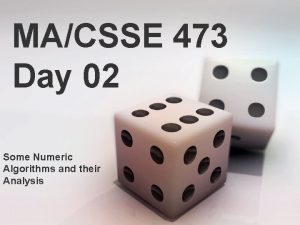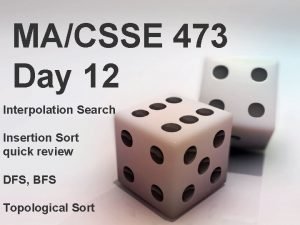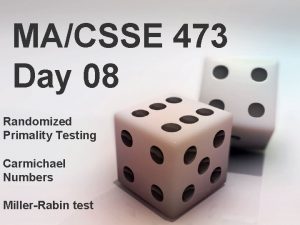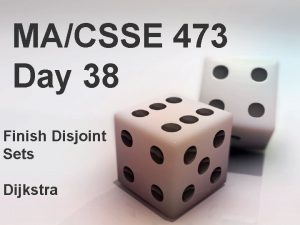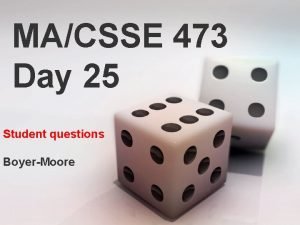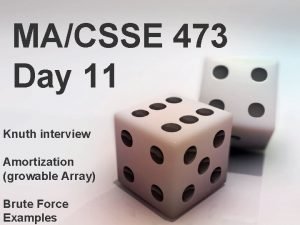MACSSE 473 Day 05 Factors and Primes Recursive




















- Slides: 20

MA/CSSE 473 Day 05 Factors and Primes Recursive division algorithm

MA/CSSE 473 Day 05 • • • HW 2 due tonight, 3 is due Monday Student Questions Asymptotic Analysis example: summation Review topics I don’t plan to cover in class Continue Algorithm Overview/Review – Integer Primality Testing and Factoring – Modular Arithmetic intro – Euclid’s Algorithm

Asymptotic Analysis Example • Find a simple big-Theta expression (as a function of n) for the following sum – when 0 < c < 1 – when c = 1 – when c > 1 • f(n) = 1 + c 2 + c 3 + … + cn

Quick look at review topics in textbook REVIEW THREAD

Textbook Topics I Won't Cover in Class • Chapter 1 topics that I will not discuss in detail unless you have questions. They should be review For some of them, there will be review problems in the homework – Sieve of Eratosthenes (all primes less than n) – Algorithm Specification, Design, Proof, Coding – Problem types : sorting, searching, string processing, graph problems, combinatorial problems, geometric problems, numerical problems – Data Structures: Array. Lists, Linked. Lists, trees, search trees, sets, dictionaries,

Textbook Topics I Won't Cover* • Chapter 2 – Empirical analysis of algorithms should be review – I believe that we have covered everything else in the chapter except amortized algorithms and recurrence relations – We will discuss amortized algorithms – Recurrence relations are covered in CSSE 230 and MA 375. We'll review particular types as we encounter them. *Unless you ask me to

Textbook Topics I Won't Cover* • Chapter 3 - Review – Bubble sort, selection sort, and their analysis – Sequential search and simple string matching *Unless you ask me to

Textbook Topics I Won't Cover* • Chapter 4 - Review – Mergesort, quicksort, and their analysis – Binary search – Binary Tree Traversal Orders (pre, post, in, level) *Unless you ask me to

Textbook Topics I Won't Cover* • Chapter 5 - Review – Insertion Sort and its analysis – Search, insertion, delete in Binary Tree – AVL tree insertion and rebalance *Unless you ask me to

Integer Division Modular arithmetic Euclid's Algorithm Heading toward Primality Testing ARITHMETIC THREAD

FACTORING and PRIMALITY • Two important problems – FACTORING: Given a number N, express it as a product of its prime factors – PRIMALITY: Given a number N, determine whether it is prime • Where we will go with this eventually – Factoring is hard • The best algorithms known so far require time that is exponential in the number of bits of N – Primality testing is comparatively easy – A strange disparity for these closely-related problems – Exploited by cryptographic algorithms • More on these problems later – First, more math and computational background…

Recap: Arithmetic Run-times • For operations on two k-bit numbers: • Addition: Ѳ(k) • Multiplication: – Standard algorithm: Ѳ(k 2) – "Gauss-enhanced": Ѳ(k 1. 59), but with a lot of overhead. • Division (We won't ponder it in detail, but see next slide): Ѳ(k 2)

Algorithm for Integer Division Let's work through divide(19, 4). Analysis?

Modular arithmetic definitions • x modulo N is the remainder when x is divided by N. I. e. , – If x = q. N + r, where 0 ≤ r < N (q and r are unique!), – then x modulo N is equal to r. • x and y are congruent modulo N, which is written as x y (mod N), if and only if N divides (x-y). – i. e. , there is an integer k such that x-y = k. N. – In a context like this, a divides b means "divides with no remainder", i. e. "a is a factor of b. " • Example: 253 13 (mod 60)

Modular arithmetic properties • Substitution rule – If x x' (mod N) and y y' (mod N), then x + y x' + y' (mod N), and xy x'y' (mod N) • Associativity – x + (y + z) (x + y) + z (mod N) • Commutativity – xy yx (mod N) • Distributivity – x(y+z) xy +yz (mod N)

Modular Addition and Multiplication • To add two integers x and y modulo N (where k = log N (the number of bits in N), begin with regular addition. – x and y are in the range_____, so x + y is in range _______ – If the sum is greater than N-1, subtract N. – Run time is Ѳ ( ) • To multiply x and y modulo N, begin with regular multiplication, which is quadratic in k. – The result is in range ______ and has at most ____ bits. – Compute the remainder when dividing by N, quadratic time. So entire operation is Ѳ( )

Modular Addition and Multiplication • To add two integers x and y modulo N (where k = log N , begin with regular addition. – x and y are in the range 0 to N-1, so x + y is in range 0 to 2 N-1 – If the sum is greater than N-1, subtract N. – Run time is Ѳ (k ) • To multiply x and y, begin with regular multiplication, which is quadratic in n. – The result is in range 0 to (N-1)2 and has at most 2 k bits. – Then compute the remainder when dividing by N, quadratic time in k. So entire operation is Ѳ(k 2)

Modular Exponentiation • In some cryptosystems, we need to compute xy modulo N, where all three numbers are several hundred bits long. Can it be done quickly? • Can we simply take xy and then figure out the remainder modulo N? • Suppose x and y are only 20 bits long. – xy is at least (219), which is about 10 million bits long. – Imagine how big it will be if y is a 500 -bit number! • To save space, we could repeatedly multiply by x, taking the remainder modulo N each time. • If y is 500 bits, then there would be 2500 bit multiplications. • This algorithm is exponential in the length of y. • Ouch!

Modular Exponentiation Algorithm • • Let k be the maximum number of bits in x, y, or N The algorithm requires at most ___ recursive calls Each call is Ѳ( ) So the overall algorithm is Ѳ( )

Modular Exponentiation Algorithm • • Let n be the maximum number of bits in x, y, or N The algorithm requires at most k recursive calls Each call is Ѳ(k 2) So the overall algorithm is Ѳ(k 3)
 Factors multiples and primes worksheet gcse
Factors multiples and primes worksheet gcse 53 multiples
53 multiples Day 1 day 2 day 3 day 4
Day 1 day 2 day 3 day 4 Macsse
Macsse Macsse
Macsse Strassens algorithm
Strassens algorithm Macsse
Macsse Analysis of non recursive algorithm
Analysis of non recursive algorithm Factors of 473
Factors of 473 Semantic primes
Semantic primes Semantic primes
Semantic primes 360 as a product of primes
360 as a product of primes 360 prime factor tree
360 prime factor tree Semantic primes
Semantic primes All primes flowchart
All primes flowchart Cyrus daboo
Cyrus daboo Day 1 day 2 day 817
Day 1 day 2 day 817 Cmpsc 473
Cmpsc 473 Cmpsc 473
Cmpsc 473 Cmpsc 473
Cmpsc 473 K=pv
K=pv

